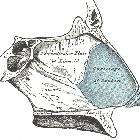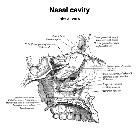Vomer


Nasal septum
• Nasal septum - Ganzer Fall bei Radiopaedia

Vomer •
Pneumatization of the vomer - Ganzer Fall bei Radiopaedia

Nasal cavity
• Nasal cavity (Gray's illustrations) - Ganzer Fall bei Radiopaedia

Nasal septum
• Vomer (Gray's illustrations) - Ganzer Fall bei Radiopaedia
The vomer is one of the facial bones and forms the postero-inferior part of the bony nasal septum. It is unpaired and lies in the midline between the two nasal cavities.
It is a thin flat bone that is trapezoidal in shape with two surfaces that are obliquely grooved by the sphenopalatine (nasopalatine) vessels and nerves.
The vomer has 4 borders:
- superior: thickest border with laterally projecting alae which articulate with the rostrum of the sphenoid bone body. The alae also articulate with the:
- sphenoidal conchae of the body of sphenoid (anterior surface)
- vaginal processes of the body of sphenoid (inferior surface)
- sphenoidal processes of the palatine bones
- inferior: articulates with the median nasal crest of the maxilla and palatine bones, between the incisive canals
- anterior: longest border which articulates with:
- the perpendicular plate of the ethmoid bone along its upper half
- the nasal septal cartilage along its lower half
- posterior: short concave border which is thicker (and bifid) superiorly and which does not articulate with any bone, but rather separates the posterior choanae
The vomerovaginal canal is formed between the ala, body of the sphenoid and the small medially directed vaginal process arising from the sphenoid bone.
Variant anatomy
Occasionally the sphenoid sinus may pneumatize the vomer .
Siehe auch:
und weiter:

 Assoziationen und Differentialdiagnosen zu Vomer:
Assoziationen und Differentialdiagnosen zu Vomer:
